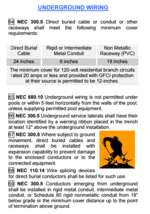endacoz
Member
The short of it.
I have a 20 am fuse from the basement going 50 foot outside to my shop. In the shop it goes into a small electrical box that splits that 20 amp to 2 15 amps.
I thought for the last 6 years that the electrical wire going outside was inside of metal conduit from the house to the shop. The electrical wire goes out of the house in 1 in metal conduit and goes into the shop inside of metal conduit. But today while lossening some soil to replant new grass in the back yard I was only digging maybe 3 inches deep and I found the wire, no metal conduit and it is just simple 12guage romex coated wire. So it appears to go from the house to the shop about 2 foot underground inside of metal conduit but apparently that is only for looks. Just the wire for 40 feet of the run.
For a long time I've wanted to put more power in the shop as if I run my heater I have to turn it off in order to use the table saw or the fuse will trip inside the house.
I live in minnesota. What is the cheapest / safest way to get more power out there. If I had more power I would run a 2hp dust collector, and other large tools. 1hp table saw. 1 3/4 hp band saw etc.
1. Whats suggested (In cold Minnesota) for conduit and wire guage to be run underground to the shed. Again about 50 feet.
2. Not sure I need 220 run out there but what are some recommendations for electrical power out to the shop. Say 60 amp out there and then split it up in its own box?
3. Any other tips you might have.
Ethan.
I need to do this in the next day or 2 or it won't happen this year!
I have a 20 am fuse from the basement going 50 foot outside to my shop. In the shop it goes into a small electrical box that splits that 20 amp to 2 15 amps.
I thought for the last 6 years that the electrical wire going outside was inside of metal conduit from the house to the shop. The electrical wire goes out of the house in 1 in metal conduit and goes into the shop inside of metal conduit. But today while lossening some soil to replant new grass in the back yard I was only digging maybe 3 inches deep and I found the wire, no metal conduit and it is just simple 12guage romex coated wire. So it appears to go from the house to the shop about 2 foot underground inside of metal conduit but apparently that is only for looks. Just the wire for 40 feet of the run.
For a long time I've wanted to put more power in the shop as if I run my heater I have to turn it off in order to use the table saw or the fuse will trip inside the house.
I live in minnesota. What is the cheapest / safest way to get more power out there. If I had more power I would run a 2hp dust collector, and other large tools. 1hp table saw. 1 3/4 hp band saw etc.
1. Whats suggested (In cold Minnesota) for conduit and wire guage to be run underground to the shed. Again about 50 feet.
2. Not sure I need 220 run out there but what are some recommendations for electrical power out to the shop. Say 60 amp out there and then split it up in its own box?
3. Any other tips you might have.
Ethan.
I need to do this in the next day or 2 or it won't happen this year!

